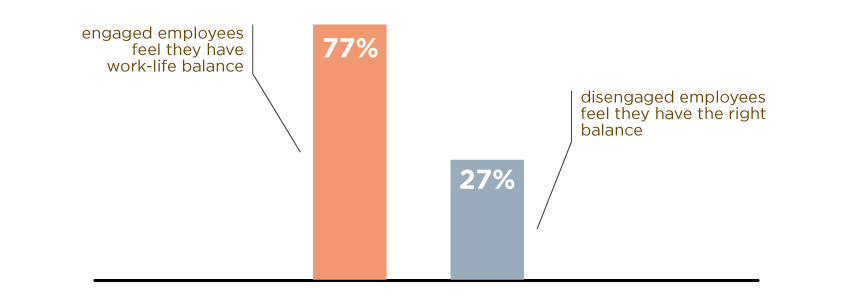Understanding the relationship between managers and employee engagement
We all know the mantra: people leave managers, not companies. And, in this case, the data backs up the anecdote.
Managers account for 70% of the variance in employee engagement scores across different business units.
Improve communication between managers and employees
Let’s break that down.
Assume your employee engagement survey results show that 100% of your Sales team is engaged at work. Assuming there are ten people in that team, that’s 10 people happy and engaged with their jobs.
Now, if the same survey shows that only 50% (5 people out of 10) in the Marketing team are engaged, you have a variance of 50% (5 people in this case) between those two teams.
What is going wrong? What difference between those two departments is causing this disparity?
According to research, the biggest single factor (70%) causing 3.5 people in your Marketing department to be disengaged is their manager.
The effect of management on employee engagement and experience is a significant factor in organizational performance, productivity, and individual wellbeing.
Why are managers important for workplace engagement?
- Managers have the most direct influence on the employees they manage
- They carry the responsibility for aligning the performance of their department and its staff with overarching organizational goals
- They play a vital role in shaping organizational culture
- They are a link between senior leaders and those operating at grass-roots level
- Manager cascades are important for effective internal communications
Given the interconnected nature of these duties, the approach, style, and success of company managers has a greater effect than any other workplace function. So, why should managers care about employee engagement and how can they help to improve it?
This blog breaks down those areas where managers have the greatest impact and explores how this affects different aspects of a business.
The role of a manager
Before we explore the ways in which a manager can impact on business results (and how to get that right) it’s worth stepping back and reminding ourselves what the role of a manager actually is.
Although the job title of ‘manager’ is used widely to describe a variety of responsibilities – from managing a function to a department or an event – we refer here to managers of people:

Though individual responsibilities vary from business to business, renowned management consultant Peter Drucker divided what he saw as the primary functions of a manager into five distinct components:
- Set objectives – setting goals for the group, and determining how best to meet those
- Organize – divide work into manageable activities, and assign these to relevant team members
- Motivate and communicate – communicating decisions clearly and creating a team ethos among staff
- Measure – establish appropriate yardsticks and targets, and analyze and interpret performance
- Develop people – developing staff as company assets
In recent years, rewarding and recognizing staff has also come to be recognized as an important element of management. A shift in talent management practices and the growth of Millennials in the workplace has seen the focus move to coaching and continual feedback, with the offer of a clear incentive or pathway essential to maintain motivation levels.
Managers and employee engagement – Three key elements
1. Managers can motivate through performance management
Improve communication between managers and employees
Building and supporting a resilient team of engaged employees through performance management is one of the key areas in which a manager can impact on business results.
A well-designed system includes regular meetings between manager and employee, offering a platform for assigning clear, measurable performance objectives as well as an opportunity for mentoring.
Despite the evidence supporting the importance of performance management, however, research shows many managers are failing to deliver on their responsibilities.


How can managers provide effective motivation through performance management?
The answer lies in a move towards agile performance management processes, rather than structured annual reviews alone. Regular appraisals enable the identification of underperformance and encourage the celebration of success, which provides reassurance for the employee that there is an obvious route to personal growth and development within the organization. Given the importance of professional development for individuals, this can be a defining factor in engagement too.
2. Managers can engage employees through positive management
Harvard Business Review cites two behaviors that impact both employee engagement and performance levels within a business.
The first of these is, unsurprisingly, communication.
There is a a strong link between consistent managerial communication and higher engagement levels, with those combining face-to-face, chat, video, phone, and intranet software creating a multichannel communications network.
However, this does not work well for every manager and evidence shows 69% of managers report feeling uncomfortable communicating with employees in general.
Investment into soft skills training for managers, combined with effective internal communication tools, may support managers in overcoming barriers to communication.
An interpersonal coaching approach to leadership also yields positive feedback, with those who feel that their manager is invested in them as a person more likely to feel engaged. Managers who can appreciate that each team member is different, and understand how best to deal with each individual personality, are crucial to fostering a culture of engagement across the team.
Second is a focus on an employee’s strengths, and building upon these, as opposed to identifying and improving weaknesses. A strengths-based culture allows team members to learn more quickly and produce a greater quality and quantity of work, allowing staff to use the best of their natural talents.
Improve communication between managers and employees
3. Supporting managers and employee engagement initiatives
Given their strategic importance and impact on individual wellbeing and engagement, managers are critically important to a successful organization.
Management consultant James A. Koroma states that in today’s global businesses, “conscious and conscientious development of competent caring leaders is critical to organizational survival”.
Being caring, empathic, and a good communicator are not inherent skills, and many managers will have achieved responsibility through seniority or expertise in their field rather than being excellent people managers.
These communication skills can be worked on though, and they should be supported if a company hopes to improve its engagement and culture. Some factors to consider when investing in leaders and managers include:
- Recognizing the specific skillset required of a manager and supporting them to develop gaps in their approach
- Guarding against over-promoting employees based solely on tenure or strong performance in an unrelated role
- Providing the necessary tools and communication channels required to connect managers with their teams
- Investing in training and up-skilling managers
- Moving towards an agile performance management culture, encouraging managers to provide frequent and informal feedback alongside structured reviews
- Developing senior leaders who coach and support, engaging with their teams, as opposed to bosses who dictate
The negative effect of bad management
Whilst the characteristics of substandard managers can be wide-ranging, from poor communication to lack of integrity or courage, the effects of these can be extremely damaging to morale and productivity.
In fact, poor management not only affects employee productivity but can also have indirect consequences for workplace innovation and the ability to adapt to changing business conditions.
One of the direct impacts of bad management can be worker stress, which could be triggered by instances of a strained relationship with a supervisor or an unmanageable workload.
It is widely accepted that engaged, productive employees achieve a healthy work-life balance; however, stress at work can carry over to misery or dread at home, resulting in an emotionally drained employee who is most likely unhappy in their job.

What’s more, poor communication – whether that be the lack of thorough instruction or an inability to give proper direction – can also contribute to poor employee productivity and low engagement. Confusion or lack of understanding is likely to lead the team member to misinterpret what has been asked of them, diminishing their own work performance and breeding resentment.
Resentment and blame culture are toxic to morale and therefore productivity, resulting in a less energetic workforce who care less about their quality of work and their overall operative level. Good managers and good managerial communication can be an important factor in rectifying this, however, provided everyone is given the right support to develop.


